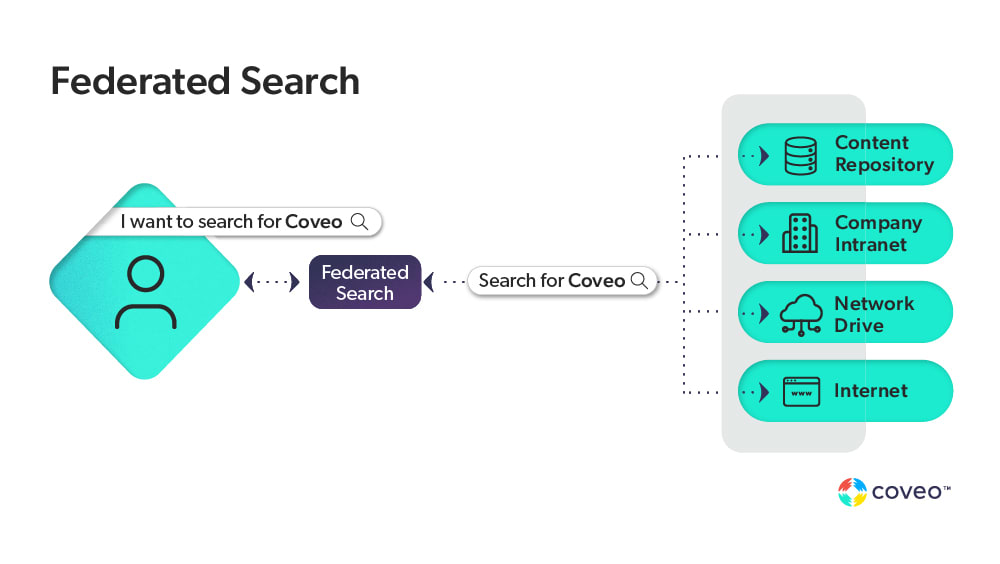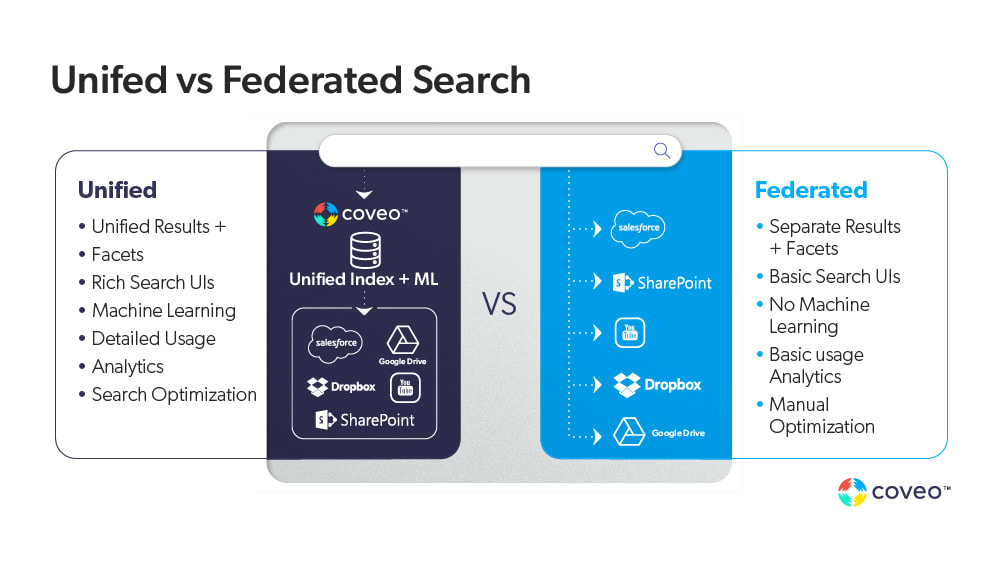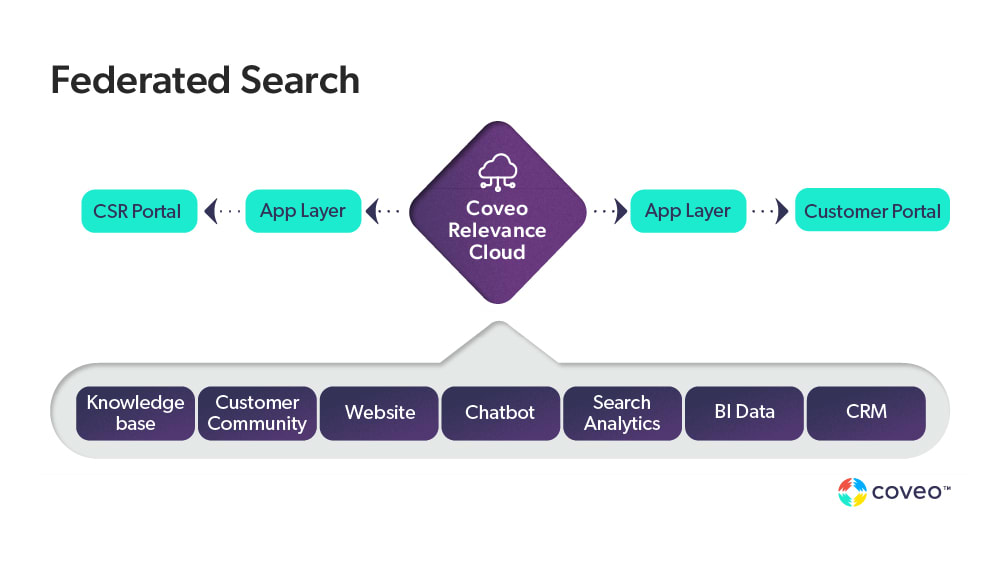A key differentiator of search technology vendors today is the notion of providing unified search. To explain what ‘unified search’ is, we have to first talk about fragmented search.
Digital interactions today are drastically different from how they were only a few years ago. In the past, visiting a website, opening an email, or using a mobile app were completely discrete experiences, with each data silo separate from the others.
We have all felt the effects of this fragmentation in our everyday lives. If you’ve ever been frustrated by customer service where the contact center representative had little to no knowledge about your problem, or, even worse, had to be updated on your previous conversation with another agent, you are familiar with the disappointing effects of a disjointed system.
The same was, and is still, common in the workplace. You might be using a collaboration app to work on a shared document. But, instead of devoting your time and effort to developing new creative ideas to further your company, you spend hours navigating the various disconnected apps, or digging for the right file, or just searching the intranet for relevant information to only realize that the knowledge you need is out of reach.
These frustrating experiences are still all too common, but unlike a few years ago, they’re easily avoided with the help of a unified search engine.
The Modern Search Experience
This is good news, because another crucial development is that people’s tolerance for fragmented search experiences is much lower than it used to be. Whether people realize it or not, they expect their digital experiences to be highly relevant and personalized just for them. They don’t want to waste additional time explaining their issue to yet another customer service agent. They expect their needs to be anticipated and their problems solved before they even spell them out. And rightly so.
Why? Because the technology that enables a unified search experience is available today. It’s used by the digital giants who set the bar for the rest of us, whether we like it or not.
Today, a buyer might start with a mobile app to search for an item. Then they’ll check online reviews of the item or ask a question about it in an online community. And then they’ll search the web for instructions on how to install it. They’ll only contact the customer service center for troubleshooting if they can’t find a solution to their problem on their own.
A unified search engine can create a layer of relevance by connecting all these disparate interactions. And if they’re connected by the right platform, the data from these interactions follows your customers as they move between channels and delivers personalization at every touchpoint.
Today, relevance is important in every sphere of digital interactions, be it ecommerce, workplace, service, or websites. Here’s how to achieve integrated search experiences with the help of a unified search engine.
What Unified Search Isn’t
Years ago, “search” meant logging into a system and typing a query into a search box. That search box could only access the one particular content source attached to it and nothing else. If you had to search more than one source, you had to go through the login and search process again, and again, and again. There was just no way to search across various content sources. If you forgot which data silo the content lives in or the password to log into a particular database, tough luck. If you had the crazy idea of comparing your search result across the sources you just searched, you were looking at hours of manual data organization and reorganization.
Luckily, those dark days of search are long gone. What came to replace them was federated search, which for the first time gave users a single interface in which to query across multiple data silos. Federated search indexes multiple data sources at once and retrieves information from all of them via a search application that’s built on top of search engine(s). So when a user makes a single search query, the federated search engine simultaneously searches multiple, usually disparate databases and ecosystems, returning results from all sources and presenting them in a single user interface.

The Rise of Federated Search
Federated search was a huge step forward from traditional search and became invaluable in complex organizations that had thousands of sources in the cloud and on-premise, where searching them via traditional search was simply impossible.
For a while, this seemed like the perfect solution to the search problem. Yet as digital interactions became more common, people’s expectations around them changed as well. Now that we spend more time in front of our screens than ever, we want these interactions to be short and to get us to our desired search result quickly. In reality, people don’t have the time or desire to search anymore.
They expect the system to anticipate their next move, interpret their misspellings correctly, and learn from their previous clicks and searches to present relevant results fast.
That means that a good, advanced search experience today requires different additional capabilities such as autocomplete, query suggestions, filtering and faceting, and so on. This is nearly impossible to achieve in federated search. Unless each separate index supports each of these capabilities, your federated search won’t be able to offer these.
In addition, with federated search, the response times will often be quite slow. Because it searches across multiple indices, the response time will be only as fast as its slowest content source. A few years ago that might not have been a problem, but shoppers’ expectations around speed have changed dramatically as well.
In other words, federated search is not enough for most organizations’ enterprise needs anymore. With federated search, it’s impossible to achieve true relevance. Because each index is searched separately, the results are ranked by source—and ranking by relevance across all content sources is impossible.
What Is a Unified Index?
A better alternative to federated search today is unified search. Unified search differs from federated search in that it creates a single unified index of content from across all content repositories. This includes the option to crawl or push content stored in the cloud or on-prem via connector library or APIs—and ranks the entire corpus in a single user interface, applying relevance across the board to deliver meaningful results.
The unified index is the staple of a unified search engine. This index can be populated by many sources, each configured to regularly retrieve items from a specific content repository, possibly along with permissions and security identities to replicate a secured system. You can pull content into an index using cloud-based hosted crawlers found in source connectors (e.g., Salesforce, Sitemap, Web, etc.) or rely on a Push API instead.

Unified search has faster query response times than federated search. This is because results are sourced from one unified index as opposed to searching multiple systems with query-time merging. By contrast, in federated search, the response times are only as fast as its slowest content source.
When your search relies on a unified search engine, relevance is applied across the entire corpus of content and can even self-optimize with the application of machine learning. That means that results will always be ranked by relevance, regardless of the source.
When you deploy a unified search engine, a better user experience is guaranteed. Search results are blended and pages can be built from a component library or APIs. Sorting, filtering, faceting and other capabilities of the search UX are built on top of the unified index.
A unified search engine solution might sound daunting and even costly—because by definition, it needs to be more comprehensive. If you are building it yourself, it can be costly in terms of resources and time to develop and deploy. If you are looking at a SaaS solution, you need to make sure it has pre-built connectors to ease integration from all those silos.
And if you want one index serving many channels, you should makes sure your solution offers a headless approach—so you can tailor the search UI to the channel itself.
AI-Powered Unified Search
Of course, once you have all that content flowing in from all those silos — how do you know which content asset is the most relevant for your search query? Machine learning models working in concert with behavioral signals help determine relevance.
Again, having to incorporate models that are tuned to your business cases (knowledge management, customer service, ecommerce) can require expensive expertise. Or, you can find a vendor who invests in AI research and development.
These off-the-shelf models can take into account several pieces of data beyond simple keyword matching; after all, it is a relevant result if you search for ‘relevance blog,’ and the title of the first result is ‘relevance blog.’ But is it really that relevant if it’s four years old, and you know there’s a newer one?

This is further complicated in use cases like ecommerce, where a search is often just a single word. No amount of manual keyword tuning is going to fix that—especially since those keywords aren’t just tied to a product, but also the context in which it was submitted. A rule can—maybe—fix this, but it’s a band-aid fix at best. Rules still require human intervention, which can increase costs.
Machine learning can take all of that off of search architects’ plates, giving them the space to create the experiences your customers want.
Conclusion: Unified Search Is Where Your Business Needs to Be
If you still equate “search” with “search box,” think again. With a unified search experience—that is, the experience that people have come to expect—every interaction informs the next interaction, across platforms and channels.
Intelligent search tailors content to you and your issue, regardless of whether you’re searching through product documentation or on the company’s website. If you still cannot find the answer and decide to contact the call center, the representative will automatically understand the issue that you are trying to solve and will see the relevant content in their knowledge base to help you solve it.
Today, your customers and employers expect nothing less than that. And the only way you can get there is with unified search.
Dig Deeper
Interested in learning more about a platform that can take your search beyond the box? To invest relevance in every touchpoint, Coveo links all your content sources together in one index. Without needing to move files anywhere. Learn more about how our intelligent search platform makes content discovery effortless, with AI-powered results you can see on day 1.


